Text
Strategic Due Diligence: Key Steps in Preparing for Mergers and Acquisitions

Mergers and acquisitions (M&A) are transformative events that can reshape the trajectory of companies, unlocking new opportunities for growth and expansion. However, the road to a successful M&A deal is fraught with challenges and uncertainties. Strategic due diligence plays a crucial role in mitigating risks, identifying synergies, and ensuring that the deal delivers the intended value to all stakeholders involved. In this blog post, we’ll explore the key steps in strategic due diligence and how they contribute to the success of M&A transactions.
1. Define Objectives and Criteria
Before embarking on an M&A journey, it’s essential for companies to define their objectives and criteria for potential targets. This involves clarifying strategic goals, identifying target markets or industries, and setting specific criteria for evaluating potential acquisitions. By clearly defining objectives and criteria upfront, companies can focus their efforts on opportunities that align with their strategic vision and offer the greatest potential for value creation.
2. Conduct Preliminary Research
Once objectives and criteria are established, companies can begin conducting preliminary research to identify potential acquisition targets. This may involve market analysis, competitor benchmarking, and industry trends analysis to identify opportunities and assess market dynamics. Additionally, companies should leverage their networks and industry contacts to gather intelligence and identify potential targets that may not be publicly known.
3. Perform Financial Analysis
Financial analysis is a critical component of strategic due diligence, helping companies assess the financial health and performance of potential acquisition targets. This involves reviewing financial statements, cash flow projections, and historical performance metrics to evaluate the target’s revenue, profitability, and growth prospects. Financial analysis also helps identify any potential red flags or areas of concern that may impact the valuation or viability of the deal.
4. Assess Operational and Technological Compatibility
In addition to financial analysis, companies should assess the operational and technological compatibility of potential acquisition targets. This involves evaluating factors such as organizational structure, operational processes, and technological infrastructure to determine compatibility with the acquiring company’s systems and processes. Assessing operational and technological compatibility early in the due diligence process can help identify integration challenges and inform post-merger integration planning.
5. Evaluate Legal and Regulatory Compliance
Legal and regulatory compliance is another critical aspect of strategic due diligence. Companies must assess the legal and regulatory landscape in which the target operates and identify any potential risks or liabilities that may arise from non-compliance. This involves reviewing contracts, licenses, permits, and regulatory filings to ensure compliance with applicable laws and regulations. Additionally, companies should assess potential legal risks, such as pending litigation or regulatory investigations, that may impact the deal.
6. Conduct Cultural Assessment
Finally, companies should conduct a cultural assessment to evaluate the compatibility of organizational cultures between the acquiring company and the target. Cultural alignment is essential for successful integration and can significantly impact employee morale, productivity, and retention post-merger. By assessing cultural fit early in the due diligence process, companies can identify potential cultural barriers and develop strategies to address them during the integration phase.
Conclusion
Strategic due diligence is a critical component of the M&A process, enabling companies to assess potential risks and opportunities and make informed decisions about potential acquisitions. By following these key steps in strategic due diligence, companies can minimize risks, identify synergies, and ensure that M&A transactions deliver the intended value to all stakeholders involved.
0 notes
Text
Navigating Cultural Integration in Company Mergers and Acquisitions

Mergers and acquisitions (M&A) are complex processes that involve more than just financial transactions. One critical aspect that often determines the success or failure of an M&A deal is cultural integration. When two companies come together, they bring with them unique cultures, values, and ways of working. Navigating this cultural integration requires careful planning, clear communication, and a deep understanding of the human elements involved.
Understanding Cultural Differences
Cultural differences can arise from various factors, including organizational structure, communication styles, leadership approaches, and even national or regional backgrounds. Before embarking on an M&A journey, it’s essential for both parties to conduct a thorough cultural assessment to identify potential areas of alignment and divergence. This assessment should go beyond surface-level observations and delve into the underlying values, norms, and behaviors that shape each organization’s culture.
Establishing Common Ground
Once cultural differences have been identified, the next step is to establish common ground and shared goals. This requires open dialogue and active engagement from both sides. Leaders should facilitate conversations that allow employees to express their concerns, share their perspectives, and find commonalities. By focusing on shared values and objectives, organizations can create a sense of unity and purpose that transcends cultural boundaries.
Clear Communication and Transparency
Effective communication is key to successful cultural integration. Leaders must be transparent about the M&A process, including its objectives, timeline, and potential impact on employees. They should provide regular updates and opportunities for feedback to ensure that employees feel informed and involved throughout the transition. Additionally, clear communication helps dispel rumors and address any misconceptions or fears that may arise during the integration process.
Fostering Collaboration and Inclusion
Cultural integration is not just about assimilating one company into another; it’s about creating a new, unified culture that values diversity and inclusion. Organizations should actively promote collaboration across teams and departments, encourage knowledge sharing, and celebrate the contributions of employees from all backgrounds. By fostering a culture of inclusivity, organizations can harness the collective talents and perspectives of their workforce to drive innovation and growth.
Respecting and Preserving Heritage
While cultural integration is essential for alignment and synergy, it’s also important to respect and preserve the heritage of each organization involved in the M&A. This means acknowledging and honoring the unique history, traditions, and achievements of both companies. Leaders should strive to create an environment where employees feel proud of their heritage and are encouraged to embrace elements of their cultural identity within the new organizational context.
Conclusion
Navigating cultural integration in company mergers and acquisitions is a complex but critical endeavor. By understanding cultural differences, establishing common ground, prioritizing clear communication and transparency, fostering collaboration and inclusion, and respecting heritage, organizations can effectively navigate the challenges of cultural integration and lay the foundation for long-term success in their M&A endeavors.
0 notes
Text
Regulatory Compliance in System Decommissioning
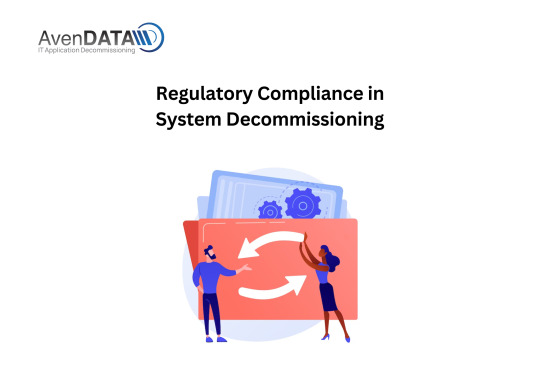
Introduction: System decommissioning is a critical process that requires organizations to retire outdated or redundant systems. However, in addition to managing the technical aspects of decommissioning, organizations must also navigate the complex landscape of regulatory compliance. Compliance with industry regulations and data protection laws is crucial to ensure the security and integrity of sensitive information during the decommissioning process. This blog explores the importance of regulatory compliance in system decommissioning and provides insights on how organizations can effectively manage this aspect of the transition while maintaining data privacy and security.
Understanding Regulatory Compliance in System Decommissioning: Regulatory compliance refers to the adherence to specific laws, regulations, and guidelines set by governing bodies. In the context of system decommissioning, compliance ensures that organizations handle sensitive data appropriately and mitigate any potential risks:
a. Data Privacy Laws: Organizations must comply with data privacy laws such as the General Data Protection Regulation (GDPR), the California Consumer Privacy Act (CCPA), or industry-specific regulations. These regulations impose requirements for the secure handling, storage, and deletion of personal data during system decommissioning.
b. Data Retention Requirements: Certain industries have specific legal requirements for data retention, and organizations must comply with these regulations during the decommissioning process. It is essential to identify and preserve data that must be retained for legal or compliance purposes.
c. Industry-Specific Regulations: Organizations operating in regulated industries, such as healthcare or finance, must comply with industry-specific regulations. These regulations often impose stringent requirements for data security, privacy, and recordkeeping, which must be considered during system decommissioning.
Key Considerations for Regulatory Compliance in System Decommissioning: To ensure regulatory compliance during system decommissioning, organizations should consider the following key aspects:
a. Data Inventory and Classification: Conduct a thorough inventory of data within the systems targeted for decommissioning. Classify the data based on its sensitivity, legal requirements, and retention obligations. This classification helps organizations understand the regulatory implications and develop appropriate strategies for data handling and disposal.
b. Secure Data Destruction: Implement secure data destruction methods to ensure that sensitive information is irretrievable after system decommissioning. This may include physical destruction, secure wiping, or using data erasure software. Document and maintain records of the data destruction process for compliance purposes.
c. Data Transfer and Storage: If data needs to be transferred or stored during the decommissioning process, organizations must ensure that appropriate security measures are in place. This may include encryption, access controls, and secure transmission protocols to safeguard data integrity and confidentiality.
d. Audit Trails and Documentation: Maintain comprehensive audit trails and documentation throughout the decommissioning process. This includes documenting data disposal methods, data transfers, and any actions taken to ensure compliance. These records serve as evidence of compliance and can be invaluable during audits or regulatory inspections.
Collaboration with Legal and Compliance Teams: To effectively manage regulatory compliance in system decommissioning, organizations must collaborate closely with their legal and compliance teams:
a. Legal Expertise: Seek guidance from legal experts who specialize in data protection, privacy laws, and industry-specific regulations. These professionals can provide insights into compliance requirements, help interpret complex regulations, and ensure that the decommissioning process aligns with legal obligations.
b. Compliance Assessments: Conduct compliance assessments to identify any potential gaps or risks related to system decommissioning. These assessments should evaluate the organization’s current practices, policies, and procedures against relevant regulations, helping to identify areas that require attention or improvement.
c. Regular Training and Awareness: Provide regular training and awareness programs to employees involved in the system decommissioning process. This ensures that they are familiar with compliance requirements, understand their responsibilities, and follow best practices to maintain regulatory compliance.
Conclusion: Regulatory compliance is a crucial aspect of system decommissioning, ensuring the security and integrity of sensitive data throughout the transition process. By understanding and adhering to data privacy laws, data retention requirements, and industry-specific regulations, organizations can mitigate risks, maintain data privacy, and protect against potential legal consequences. Conducting a thorough data inventory, implementing secure data destruction methods, collaborating with legal and compliance teams, and maintaining comprehensive documentation are key steps towards achieving regulatory compliance in system decommissioning. Embrace regulatory compliance as an integral part of the process, and navigate the path to a secure and compliant transition.
#AvenDATA #systemdecommissioning #itdecommissioning #decommissioning #legacydata
0 notes
Text
Legacy Data Archiving Strategies for Compliance in Liquidation Proceedings

In the process of liquidating IT assets, one critical aspect that often gets overlooked is the management of legacy data. Data accumulated over years of operation can pose significant challenges during liquidation proceedings, especially concerning compliance with regulatory requirements. To address these challenges, organizations must implement effective legacy data archiving strategies tailored to the specific demands of liquidation. In this article, we delve into the importance of legacy data archiving for compliance in liquidation proceedings and explore strategies to ensure regulatory adherence.
1. Understanding Regulatory Obligations: Before devising a legacy data archiving strategy, organizations must first understand the regulatory landscape governing data management and retention. Depending on the industry and geographical location, various regulations such as GDPR, HIPAA, SOX, and CCPA impose specific requirements regarding data retention, privacy, and security. By comprehensively understanding these obligations, organizations can tailor their archiving strategies to ensure compliance.
2. Identifying Critical Data Sets: Not all data stored in legacy systems holds equal importance from a compliance perspective. During the liquidation process, organizations should identify and prioritize critical data sets that must be retained for compliance purposes. This may include customer records, financial transactions, intellectual property documents, and legal agreements. By focusing on preserving essential data sets, organizations can streamline the archiving process and minimize storage costs.
3. Implementing Secure Archiving Solutions: Legacy data archiving requires robust and secure solutions to ensure the integrity and confidentiality of archived information. Organizations should invest in modern archiving platforms equipped with encryption, access controls, and audit trails to safeguard archived data from unauthorized access or tampering. Cloud-based archiving solutions offer scalability and flexibility, allowing organizations to adapt to evolving compliance requirements.
4. Defining Retention Policies: Establishing clear retention policies is essential for managing legacy data throughout the liquidation process. Retention policies dictate how long data should be retained based on regulatory requirements, business needs, and legal considerations. By defining retention periods for different types of data, organizations can ensure compliance with regulatory mandates while minimizing the risk of retaining unnecessary data.
5. Regular Auditing and Monitoring: Continuous auditing and monitoring of archived data are crucial to ensuring ongoing compliance with regulatory requirements. Organizations should periodically review archived data to identify any discrepancies, unauthorized accesses, or data breaches. Regular audits help validate the effectiveness of archiving procedures and ensure adherence to compliance standards.
6. Secure Data Destruction Protocols: In addition to archiving essential data, organizations must also implement secure data destruction protocols to dispose of non-essential or outdated information securely. Proper data destruction techniques, such as data wiping, shredding, or degaussing, should be employed to permanently erase data from storage devices and prevent unauthorized recovery. Documenting the data destruction process is essential for demonstrating compliance with regulatory requirements.
7. Partnering with Compliance Experts: Navigating the complexities of legacy data archiving and compliance in liquidation proceedings requires expertise in regulatory compliance and data management. Organizations can benefit from partnering with compliance experts, legal advisors, and experienced archiving service providers to develop and implement robust archiving strategies tailored to their specific compliance needs. Leveraging external expertise ensures that organizations stay abreast of regulatory changes and maintain compliance throughout the liquidation process.
In conclusion, legacy data archiving plays a pivotal role in ensuring compliance during IT asset liquidation proceedings. By understanding regulatory obligations, identifying critical data sets, implementing secure archiving solutions, defining retention policies, conducting regular audits, implementing secure data destruction protocols, and partnering with compliance experts, organizations can effectively manage legacy data and mitigate compliance risks during liquidation proceedings. Prioritizing compliance in legacy data archiving efforts not only safeguards organizations against regulatory penalties but also fosters trust and transparency in the liquidation process.
0 notes
Text
Change Management in System Decommissioning
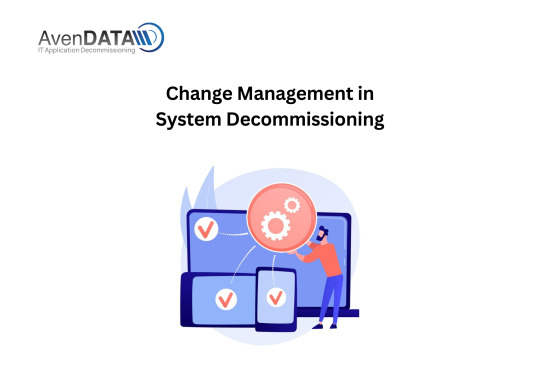
Introduction: System decommissioning is a complex process that requires careful planning, coordination, and effective change management. Successfully navigating the path of system decommissioning involves addressing the challenges associated with organizational change, stakeholder engagement, and ensuring a smooth transition. In this blog, we explore the importance of change management in system decommissioning and provide insights on how organizations can effectively manage this critical aspect of the transformation journey.
Understanding the Need for Change Management: Change management is essential in system decommissioning as it helps organizations navigate the human aspects of the transition. Recognizing the need for change management ensures a structured approach to address resistance, mitigate risks, and maximize the benefits of decommissioning:
a. Stakeholder Engagement: Change management facilitates effective communication and engagement with stakeholders, ensuring that their concerns and perspectives are addressed. Stakeholders may include end-users, IT teams, management, and external partners or customers impacted by the decommissioning process.
b. Managing Resistance: Change often brings resistance. Change management strategies help identify potential resistance points and develop strategies to address them. By fostering a culture of openness, transparency, and providing clear reasoning for the decommissioning, organizations can reduce resistance and gain buy-in from stakeholders.
c. Risk Mitigation: Effective change management helps organizations identify and mitigate potential risks associated with system decommissioning. By proactively addressing risks such as data loss, disruption to business operations, or security vulnerabilities, organizations can develop contingency plans and mitigate potential negative impacts.
Building a Change Management Plan: A well-structured change management plan is crucial for successful system decommissioning. Consider the following key elements when creating a change management plan:
a. Clear Objectives and Vision: Clearly define the objectives, benefits, and vision of the system decommissioning initiative. This clarity provides a guiding framework for all stakeholders and ensures alignment across the organization.
b. Stakeholder Analysis and Engagement: Identify key stakeholders impacted by the decommissioning process and analyze their needs, concerns, and expectations. Develop tailored communication and engagement strategies to effectively involve and address their perspectives.
c. Communication Strategy: Establish a comprehensive communication strategy that includes regular updates, informative materials, and channels for two-way communication. Communication should be timely, transparent, and focused on addressing stakeholder concerns and keeping them informed throughout the process.
d. Training and Support: Develop training programs and support mechanisms to help stakeholders adapt to new systems, processes, and workflows. Effective training and support empower stakeholders, reduce resistance, and ensure a smooth transition.
e. Change Champions: Identify change champions within the organization who can act as advocates for the decommissioning initiative. These individuals can provide support, address concerns, and serve as role models for embracing the change.
Monitoring and Evaluation: Change management is an ongoing process that requires continuous monitoring and evaluation. Regularly assess the effectiveness of change management strategies and make adjustments as needed:
a. Feedback Mechanisms: Establish feedback mechanisms to gather input from stakeholders throughout the decommissioning process. Actively listen to concerns, suggestions, and feedback, and incorporate them into the change management plan.
b. Key Performance Indicators (KPIs): Define KPIs to measure the success of the change management efforts. These KPIs can be related to stakeholder satisfaction, adoption rates, productivity, or other relevant metrics. Regularly review and analyze these KPIs to assess the impact of change management strategies and make informed adjustments.
c. Continuous Improvement: Embrace a culture of continuous improvement by using insights gained from monitoring and evaluation to refine change management strategies. Learning from past experiences and adjusting the approach based on feedback and lessons learned contributes to the overall success of the system decommissioning initiative.
Conclusion: Change management is a critical component of successful system decommissioning. By actively engaging stakeholders, managing resistance, and addressing potential risks, organizations can navigate the complexities of change, ensuring a smooth transition and maximizing the benefits of system decommissioning. Building a comprehensive change management plan, including clear objectives, stakeholder engagement, effective communication, training and support, and continuous monitoring, enables organizations to effectively manage the human aspects of the transformation process. Embrace change management in system decommissioning and pave the way for a successful and seamless transition towards a more streamlined and efficient IT infrastructure.
#AvenDATA #systemdecommissioning #itdecommissioning #decommissioning #legacydata
0 notes
Text
Ensuring Compliance in IT Legacy Systems Liquidation: Regulatory Considerations

In today’s dynamic business environment, companies often undergo changes that require them to liquidate their IT legacy systems. Whether it’s due to mergers, acquisitions, restructuring, or technological upgrades, the process of liquidating IT assets requires careful attention to regulatory compliance. Failure to comply with relevant laws and regulations can lead to legal liabilities, financial penalties, and damage to the organization’s reputation. Therefore, it’s crucial for businesses to understand and address the regulatory considerations involved in IT legacy systems liquidation. Let’s explore some key regulatory factors that organizations should consider to ensure compliance during the liquidation process.
1. Data Privacy Regulations: One of the primary regulatory considerations in IT legacy systems liquidation is data privacy. Various regulations, such as the General Data Protection Regulation (GDPR) in the European Union, the Health Insurance Portability and Accountability Act (HIPAA) in the United States, and the Personal Data Protection Act (PDPA) in Singapore, govern the collection, storage, and processing of personal data. Organizations must ensure that sensitive data stored in legacy systems is handled and disposed of in accordance with these regulations to protect individuals’ privacy rights.
2. Intellectual Property Protection: Intellectual property (IP) assets, including patents, trademarks, copyrights, and trade secrets, are valuable assets that must be protected during IT legacy systems liquidation. Organizations should implement measures to safeguard their IP assets from unauthorized access, disclosure, or misuse. This may include restricting access to proprietary software code, encryption of confidential documents, and contractual agreements with third-party vendors to protect trade secrets.
3. Environmental Regulations: The disposal of IT hardware and electronic equipment during legacy systems liquidation may be subject to environmental regulations governing e-waste management and recycling. Organizations must ensure compliance with these regulations to minimize the environmental impact of IT asset disposal. This may involve proper recycling of electronic waste, disposal of hazardous materials, and adherence to local laws regarding electronic waste disposal.
4. Financial Reporting Requirements: Financial reporting requirements, such as those outlined in the Generally Accepted Accounting Principles (GAAP) or International Financial Reporting Standards (IFRS), dictate how organizations report the value of their assets, including IT systems, in their financial statements. Organizations must accurately account for the value of IT assets being liquidated and properly disclose any related financial transactions or liabilities in their financial reports.
5. Employment Laws and Regulations: IT legacy systems liquidation may involve workforce restructuring, including employee layoffs or transfers. Organizations must comply with applicable employment laws and regulations governing employee termination, severance pay, notice periods, and employee rights during the liquidation process. Failure to adhere to these laws can result in legal disputes, lawsuits, and reputational damage.
6. Contractual Obligations: Organizations must review and assess any contractual obligations related to their IT legacy systems, including agreements with software vendors, service providers, and clients. Contracts may contain clauses specifying data retention requirements, termination procedures, and intellectual property rights that must be considered during the liquidation process. Organizations should ensure compliance with contractual obligations to avoid breach of contract claims and legal disputes.
7. Records Retention Requirements: Certain industries and jurisdictions may have records retention requirements that dictate how long organizations must retain certain types of records and data. Organizations should review applicable records retention laws and regulations to determine their obligations regarding the retention and disposal of data stored in IT legacy systems. Properly managing records retention ensures compliance with legal requirements and reduces the risk of non-compliance penalties.
In conclusion, ensuring compliance with regulatory requirements is essential for organizations undergoing IT legacy systems liquidation. By understanding and addressing key regulatory considerations such as data privacy regulations, intellectual property protection, environmental regulations, financial reporting requirements, employment laws, contractual obligations, and records retention requirements, organizations can mitigate legal and financial risks associated with the liquidation process. Partnering with experienced professionals and legal advisors can help organizations navigate complex regulatory landscapes and ensure compliance throughout the liquidation process.
0 notes
Text
The Role of Data Analytics in System Decommissioning
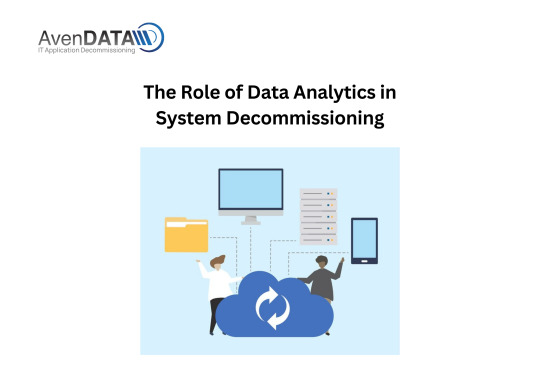
Introduction: System decommissioning is a critical process that allows organizations to retire outdated or redundant systems, streamline IT infrastructure, and optimize resources. In this digital age, data analytics plays a crucial role in facilitating effective system decommissioning. By harnessing the power of data analytics, organizations can gain valuable insights, make informed decisions, and ensure a smooth and successful transition. This blog explores the role of data analytics in system decommissioning, highlighting its benefits and best practices for leveraging this transformative approach.
Data Analysis for System Assessment: Data analytics plays a pivotal role in assessing the value and relevance of systems targeted for decommissioning. By analyzing relevant data, organizations can gain insights into system usage, performance, and dependencies, enabling informed decision-making:
a. Usage Patterns: Analyzing usage patterns helps identify systems that are no longer actively used or have become redundant. By understanding the frequency and intensity of system usage, organizations can determine the necessity of maintaining those systems.
b. Performance Evaluation: Data analytics enables organizations to assess the performance of systems targeted for decommissioning. Analyzing metrics such as response times, error rates, and resource utilization provides a comprehensive understanding of system effectiveness and highlights areas for improvement.
c. Dependency Mapping: Data analytics helps organizations identify dependencies between systems, applications, and data. By mapping these dependencies, organizations gain insights into the broader impact of decommissioning a particular system and can plan for smooth transitions or necessary replacements.
Data Cleansing and Migration: During system decommissioning, data analytics plays a crucial role in data cleansing and migration processes, ensuring the integrity and security of valuable information:
a. Data Cleansing: Analyzing data from legacy systems helps identify duplicate, incomplete, or outdated records. Data cleansing ensures that only accurate and relevant data is migrated or retained, reducing the risk of errors and improving data quality in the new system.
b. Data Migration Planning: Data analytics provides insights into the volume, format, and structure of data in legacy systems. This information is instrumental in developing a comprehensive data migration plan, including mapping data fields, ensuring compatibility with the new system, and minimizing data loss or corruption.
c. Data Validation: Data analytics helps validate the accuracy and consistency of migrated data. By comparing data from the legacy system with the migrated data, organizations can identify any discrepancies or errors, ensuring the integrity and reliability of the new system.
Business Insights and Process Optimization: Data analytics not only supports the technical aspects of system decommissioning but also enables organizations to gain valuable business insights and optimize processes:
a. Identifying Efficiency Gaps: Analyzing data from legacy systems provides insights into inefficiencies or bottlenecks in existing processes. This information helps organizations identify opportunities for process optimization, automation, and streamlining, leading to improved operational efficiency.
b. Cost Analysis: Data analytics enables organizations to assess the financial impact of system decommissioning, including cost savings from reduced maintenance, licensing, and infrastructure support. This analysis provides a clear understanding of the return on investment and helps justify the decommissioning decision.
c. Risk Assessment: Data analytics helps organizations assess the potential risks associated with system decommissioning. By analyzing data security, compliance requirements, and potential impacts on business operations, organizations can develop robust risk mitigation strategies and ensure a smooth transition.
Conclusion: Data analytics plays a vital role in system decommissioning, providing organizations with valuable insights to make informed decisions, streamline processes, and optimize resources. By leveraging data analytics, organizations can assess system usage, evaluate performance, map dependencies, cleanse and migrate data, gain business insights, and optimize processes. Successful system decommissioning requires a thorough understanding of the data landscape and a strategic approach to data analytics. Embrace the power of data analytics in system decommissioning, and unlock the full potential of your organization’s digital transformation journey.
#AvenDATA #systemdecommissioning #itdecommissioning #decommissioning #legacydata
0 notes
Text
Data Security Measures in IT Liquidation: Safeguarding Sensitive Information
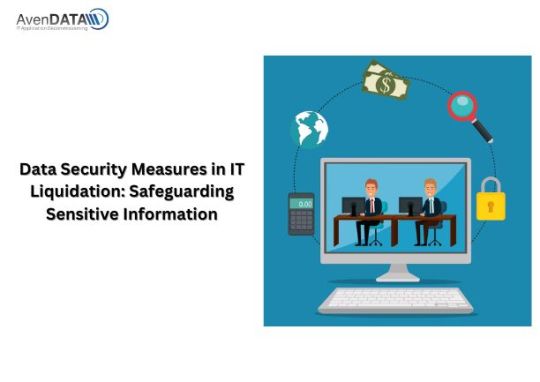
In the fast-paced world of business, companies are often faced with the need to liquidate their IT assets due to various reasons such as restructuring, mergers, or technological advancements. However, amidst the rush to dispose of hardware and software, one critical aspect that must not be overlooked is data security. In today’s digital age, where data breaches and cyber threats are rampant, ensuring the protection of sensitive information during IT liquidation is paramount. Let’s explore some essential data security measures that organizations should implement to safeguard their valuable data during the liquidation process.
1. Data Inventory and Classification: Before initiating the liquidation process, organizations should conduct a comprehensive inventory of all data stored on their IT assets. This includes identifying sensitive information such as customer data, financial records, intellectual property, and proprietary business information. Once the data is inventoried, classify it based on its sensitivity level to prioritize protection efforts.
2. Data Encryption: Encrypting data is an effective way to protect it from unauthorized access, even if the hardware falls into the wrong hands. Implement robust encryption protocols to encrypt data both at rest and in transit. This ensures that even if the hardware is sold or disposed of, the data remains inaccessible to unauthorized users.
3. Secure Data Erasure: Prior to disposing of hardware assets, it is essential to securely erase all data stored on them. Simply deleting files or formatting drives may not completely remove sensitive information, as it can still be recovered using data recovery tools. Employ certified data erasure methods such as overwriting, degaussing, or physical destruction to ensure data irreversibility.
4. Compliance with Data Protection Regulations: Organizations must adhere to relevant data protection regulations such as GDPR, HIPAA, or CCPA when handling and disposing of sensitive data during IT liquidation. Ensure that the liquidation process complies with all legal requirements regarding data privacy, security, and disclosure. Failure to comply with regulations can result in severe penalties and reputational damage.
5. Vendor Due Diligence: When selecting vendors or service providers for IT asset disposal, conduct thorough due diligence to ensure they have robust data security practices in place. Verify that the vendor follows industry-standard protocols for data erasure and disposal and request documentation certifying compliance with data protection regulations.
6. Chain of Custody Tracking: Maintain a detailed chain of custody log to track the movement and handling of IT assets throughout the liquidation process. Document each step of the data disposal process, including who accessed the data, when, and for what purpose. This provides accountability and transparency and helps mitigate the risk of data breaches.
7. Employee Training and Awareness: Educate employees involved in the liquidation process about the importance of data security and their role in safeguarding sensitive information. Provide training on best practices for data handling, secure data erasure methods, and recognizing potential security threats such as phishing scams or social engineering attacks.
8. Regular Security Audits and Assessments: Conduct regular security audits and assessments to identify vulnerabilities in data security practices and infrastructure. Perform penetration testing, vulnerability scanning, and risk assessments to proactively identify and address potential security gaps. Regular audits help ensure ongoing compliance with data protection standards and industry best practices.
In conclusion, data security should be a top priority during IT liquidation to mitigate the risk of data breaches, regulatory non-compliance, and reputational damage. By implementing robust data security measures such as encryption, secure data erasure, compliance with regulations, and employee training, organizations can effectively safeguard their sensitive information throughout the liquidation process.
0 notes
Text
System Decommissioning and Virtualization Technologies
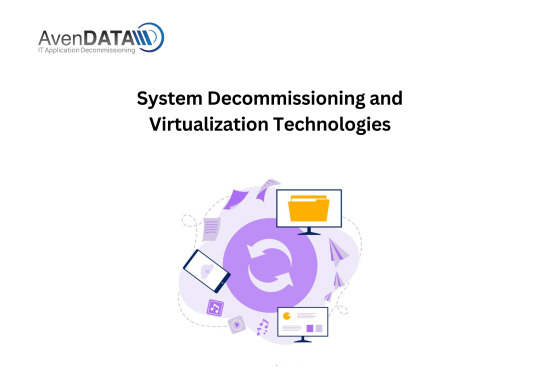
Introduction: As technology evolves rapidly, organizations must adapt to keep pace with the changing IT landscape. System decommissioning and virtualization technologies have emerged as powerful strategies for streamlining IT infrastructure, reducing costs, and improving operational efficiency. This blog explores the benefits and considerations of system decommissioning and virtualization technologies, shedding light on how organizations can harness these approaches to optimize their IT environments.
System Decommissioning: Streamlining IT Infrastructure System decommissioning involves the retirement and removal of outdated or redundant IT systems from the organizational landscape. By eliminating unnecessary systems, organizations can achieve several benefits:
a. Cost Reduction: Decommissioning systems that are no longer in use or have become redundant allows organizations to reduce costs associated with maintenance, licensing, and infrastructure support. This reallocation of resources can be directed towards more strategic initiatives.
b. Simplified Operations: Removing obsolete systems simplifies IT operations, eliminating the need to manage and maintain outdated infrastructure. This streamlining allows IT teams to focus on more critical tasks and reduces the risk of potential security vulnerabilities.
c. Enhanced Security: Decommissioning systems that are no longer actively supported or updated reduces the risk of security breaches. Outdated systems are more vulnerable to attacks as they lack the latest security patches and updates. Removing these systems mitigates potential risks and strengthens overall security posture.
d. Improved Performance: By decommissioning unnecessary systems, organizations can optimize performance by reducing the burden on resources such as storage, processing power, and network bandwidth. This results in improved system performance and better overall user experience.
Virtualization Technologies: Efficient Resource Utilization Virtualization technologies, such as server virtualization and desktop virtualization, enable organizations to optimize resource utilization, improve scalability, and enhance flexibility:
a. Server Virtualization: Server virtualization allows multiple virtual servers to run on a single physical server, effectively consolidating hardware resources. This technology enables organizations to reduce the number of physical servers required, resulting in cost savings, energy efficiency, and simplified management.
b. Desktop Virtualization: Desktop virtualization separates the desktop environment from the physical machine, allowing users to access their desktops remotely. This technology provides flexibility, as users can access their desktops from any device, enhances security by centralizing data storage, and simplifies software deployment and management.
c. Storage Virtualization: Storage virtualization abstracts physical storage resources, allowing for centralized management and increased flexibility. This technology simplifies storage provisioning, improves data availability, and optimizes storage utilization by pooling resources across multiple storage devices.
d. Network Virtualization: Network virtualization abstracts network resources, enabling organizations to create virtual networks that are independent of the physical infrastructure. This technology enhances network agility, simplifies network management, and enables the efficient provisioning of network services.
Considerations and Best Practices: When implementing system decommissioning and virtualization technologies, organizations should consider the following:
a. Comprehensive Planning: Develop a comprehensive plan that includes an inventory of existing systems, a prioritization framework for decommissioning, and a roadmap for virtualization implementation. This planning ensures a systematic and efficient approach to the transformation process.
b. Data Migration and Retention: When decommissioning systems, organizations must carefully plan data migration and retention strategies. Ensure data integrity during the migration process and adhere to legal and compliance requirements for data retention.
c. Performance and Scalability: Assess performance requirements and scalability needs before implementing virtualization technologies. Adequate resource allocation and capacity planning are crucial to ensure optimal performance and accommodate future growth.
d. Security and Compliance: As organizations transition to virtualized environments, security and compliance measures must be a top priority. Implement robust security controls, regularly update software, and adhere to industry regulations to protect data and mitigate risks.
Conclusion: System decommissioning and virtualization technologies offer organizations the opportunity to streamline IT infrastructure, reduce costs, and enhance operational efficiency. By removing redundant systems, organizations can optimize resource utilization, improve security, and simplify IT operations. Virtualization technologies further enhance efficiency by consolidating resources, improving scalability, and providing flexibility. However, careful planning, data migration strategies, performance considerations, and security measures are vital for successful implementation. Embrace the power of system decommissioning and virtualization technologies, and unlock the full potential of your IT infrastructure.
#AvenDATA #systemdecommissioning #itdecommissioning #decommissioning #legacydata
0 notes
Text
Liquidation Planning for IT Assets: Strategies for Maximizing Recovery
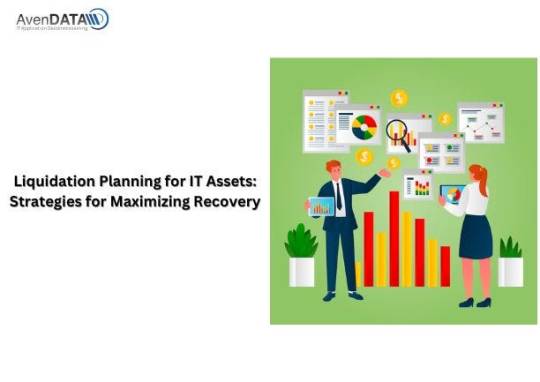
In the corporate landscape, liquidation is an inevitable reality that businesses may face due to various factors such as financial distress, restructuring, or market shifts. When navigating the process of liquidation, one of the critical areas of concern is managing IT assets effectively. From hardware to software licenses, these assets hold significant value, and maximizing recovery during liquidation requires careful planning and execution. In this blog post, we’ll delve into key strategies for liquidation planning specifically tailored to IT assets.
1. Conduct a Comprehensive Inventory: Before embarking on liquidation, it’s crucial to conduct a thorough inventory of all IT assets within the organization. This includes hardware components such as servers, networking equipment, and computers, as well as software licenses, subscriptions, and intellectual property rights. A comprehensive inventory provides clarity on the assets available for liquidation and helps in assessing their market value.
2. Evaluate Asset Utilization and Condition: Assessing the utilization and condition of IT assets is essential for determining their resale value. Assets that are in good working condition and have been well-maintained are likely to fetch higher prices in the secondary market. Conversely, outdated or obsolete equipment may have limited resale value and may need to be disposed of through environmentally responsible means.
3. Prioritize Asset Recovery: Not all IT assets hold the same value, and prioritizing recovery efforts can help maximize returns during liquidation. Identify high-value assets that are in demand in the secondary market and focus on recovering them first. Additionally, consider the resale potential of software licenses, subscription contracts, and other intangible assets.
4. Explore Liquidation Channels: When liquidating IT assets, organizations have several options for disposal, including auctions, resale vendors, asset recovery firms, and online marketplaces. Each channel offers different advantages and disadvantages in terms of speed, convenience, and potential returns. Evaluate these options carefully to determine the most suitable approach for liquidating your IT assets.
5. Ensure Data Security and Compliance: Data security is paramount during the liquidation process, especially when disposing of hardware that may contain sensitive information. Implement robust data erasure procedures to securely wipe all data from storage devices before resale or disposal. Additionally, ensure compliance with relevant regulations such as GDPR, HIPAA, or industry-specific data protection standards.
6. Negotiate Vendor Contracts: Review existing vendor contracts and agreements related to IT assets, including warranties, maintenance contracts, and software licenses. Explore opportunities to renegotiate or terminate these contracts to reduce ongoing expenses during liquidation. Negotiating favorable terms with vendors can help minimize costs and maximize recovery.
7. Plan for Environmental Sustainability: Sustainable disposal of IT assets is increasingly important for organizations seeking to minimize their environmental footprint. Explore options for recycling or repurposing equipment to extend its lifecycle and reduce electronic waste. Partnering with certified e-waste recyclers ensures compliance with environmental regulations and promotes responsible stewardship of resources.
8. Document the Liquidation Process: Maintain detailed records of the liquidation process, including inventory lists, asset valuations, sales contracts, and disposal certificates. Documentation provides transparency and accountability, which is essential for compliance purposes and potential audits. Keep stakeholders informed throughout the liquidation process to maintain trust and credibility.
In conclusion, effective liquidation planning for IT assets requires careful consideration of factors such as asset valuation, resale channels, data security, and environmental sustainability. By following the strategies outlined above, organizations can maximize recovery, minimize risks, and navigate the liquidation process with confidence and efficiency.
0 notes
Text
Embracing Transformation: Unlocking the Potential of Legacy Systems
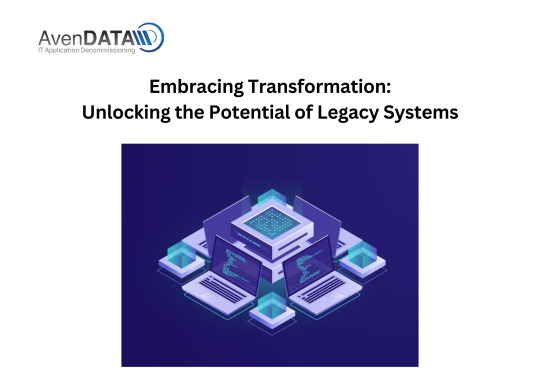
Introduction: Legacy systems have long been considered the outdated relics of the past, often perceived as barriers to innovation and progress. However, it’s time to challenge this perception and recognize the untapped potential that lies within these systems. In this blog, we explore how organizations can embrace transformation and unlock the hidden value of their legacy systems, paving the way for innovation, efficiency, and sustained success.
Reassessing Legacy Systems: To unlock the potential of IT legacy systems, organizations must first reassess their value and capabilities. Instead of viewing them as obstacles, consider the following perspectives:
a. Institutional Knowledge: Legacy systems often contain valuable institutional knowledge and insights that have been refined over time. This expertise can provide a competitive advantage by enabling organizations to make informed decisions, anticipate customer needs, and optimize processes.
b. Stability and Reliability: Legacy systems, though built on older technologies, have a proven track record of stability and reliability. By preserving and optimizing these systems, organizations can ensure uninterrupted service delivery, build customer trust, and maintain a competitive edge.
c. Integration Capabilities: Legacy systems are often deeply integrated with other applications and processes within an organization. This integration capability can be leveraged to seamlessly connect with new technologies, enabling a gradual and cost-effective modernization process.
Modernizing in Phases: To embrace transformation, organizations can adopt a phased approach to modernizing their legacy systems. This approach allows for a gradual transition, minimizing disruption and maximizing the value derived from existing investments. Key steps in the modernization process include:
a. Assessing Modernization Needs: Identify areas where legacy systems are hindering business growth or efficiency. Determine the specific functionalities or components that require modernization and align them with strategic objectives.
b. Defining a Modernization Strategy: Develop a comprehensive strategy that outlines the timeline, goals, and resources required for modernization. Consider factors such as budget constraints, risk mitigation, and the impact on existing operations.
c. Prioritizing Modernization Efforts: Prioritize the functionalities or components that will yield the most significant benefits when modernized. This may include customer-facing applications, backend processes, or data management systems that have a direct impact on business outcomes.
d. Leveraging Hybrid Solutions: Rather than discarding legacy systems entirely, embrace hybrid solutions that combine the strengths of both legacy and modern technologies. This approach allows for a seamless integration of new capabilities while preserving the core functionality and institutional knowledge of legacy systems.
Implementing Agile Development: Adopting agile development methodologies can greatly facilitate the modernization process of legacy systems. By breaking down the modernization effort into smaller, manageable tasks, organizations can iterate, test, and deploy updates more efficiently. Agile development enables faster response times, increased collaboration, and a higher level of adaptability to evolving business needs.
Investing in Training and Change Management: Successful transformation requires investing in training and change management initiatives. Empower employees with the necessary skills and knowledge to embrace new technologies and processes. Communicate the benefits of modernization, address concerns, and foster a culture of continuous learning and adaptation.
Ensuring Security and Compliance: As organizations modernize their legacy systems, it is crucial to prioritize security and compliance. Implement robust cybersecurity measures, regularly update software, and conduct thorough vulnerability assessments. Ensure compliance with industry regulations and data protection laws to safeguard sensitive information and maintain trust with customers.
Conclusion: Legacy systems should no longer be viewed as barriers to innovation, but rather as untapped opportunities for organizations to embrace transformation. By reassessing the value of legacy systems, adopting a phased modernization approach, implementing agile development methodologies, investing in training and change management, and prioritizing security and compliance, organizations can unlock the potential of their legacy systems. Through this transformation, organizations can drive innovation, improve efficiency, and position themselves for sustained success in the dynamic and ever-evolving business landscape. Embrace the power of transformation, and unlock the hidden potential within your legacy systems.
#avendata #legacysystems #legacysystem #itsystems #itlegacysystems
0 notes
Text
Insolvency Impact on IT Legacy Systems: Risks and Opportunities

In the fast-paced world of business, insolvency can strike unexpectedly, posing significant challenges to organizations of all sizes. When a company faces insolvency, its IT legacy systems often become a focal point of concern. These systems, which may have been meticulously built and maintained over the years, suddenly face uncertain futures. In this article, we’ll explore the risks and opportunities that insolvency presents for IT legacy systems and how businesses can navigate this challenging terrain.
Risks:
Data Loss: One of the most immediate risks associated with insolvency is the potential loss of valuable data stored within legacy systems. Without proper management and oversight, critical information may be lost or compromised during the liquidation process.
Security Breaches: Insolvency can create vulnerabilities in IT systems, making them more susceptible to security breaches and cyberattacks. Hackers may exploit weaknesses in outdated software or infrastructure, leading to data breaches and financial losses.
Compliance Concerns: Insolvency often triggers a flurry of legal and regulatory obligations, including data protection laws, industry standards, and contractual agreements. Failing to meet these compliance requirements can result in legal repercussions and damage to the company’s reputation.
Operational Disruption: As a company navigates insolvency proceedings, its day-to-day operations may be disrupted, impacting the availability and functionality of IT systems. This disruption can hinder productivity, strain customer relationships, and impede business continuity.
Opportunities:
Modernization Initiatives: Insolvency can provide an opportunity for organizations to reassess their IT infrastructure and explore modernization initiatives. By investing in newer technologies and platforms, businesses can enhance efficiency, agility, and competitiveness.
Cost Optimization: Insolvency forces companies to scrutinize their expenses and identify areas for cost optimization. By decommissioning outdated or redundant IT systems, organizations can reduce maintenance costs and streamline operations.
Data Consolidation: Insolvency often involves consolidating assets and streamlining operations to maximize value. This presents an opportunity for businesses to rationalize their data holdings, consolidate disparate systems, and improve data management practices.
Agile Adaptation: In times of financial distress, companies must be agile and adaptable to survive. Insolvency can prompt organizations to embrace change, innovate new business models, and pivot toward more sustainable practices.
Navigating the Challenges:
Strategic Planning: To mitigate the risks associated with insolvency, organizations must develop strategic plans for managing their IT legacy systems. This includes conducting thorough assessments, identifying critical assets, and prioritizing data protection efforts.
Collaboration and Communication: Effective communication and collaboration between stakeholders are essential for navigating insolvency proceedings. IT teams, legal advisors, and financial experts must work together to address challenges and seize opportunities.
Data Protection Measures: Implementing robust data protection measures is paramount to safeguarding sensitive information during insolvency. This may involve data encryption, access controls, regular backups, and compliance with relevant regulations.
Continuous Monitoring: Insolvency is a dynamic process that requires continuous monitoring and adaptation. Organizations must stay vigilant, anticipate potential risks, and adjust their strategies accordingly to ensure the smooth operation of IT legacy systems.
In conclusion, while insolvency poses significant risks to IT legacy systems, it also presents opportunities for organizations to reassess their technology infrastructure, optimize costs, and embrace innovation. By adopting strategic planning, collaboration, and data protection measures, businesses can navigate the challenges of insolvency and emerge stronger and more resilient in the long run.
0 notes
Text
Navigating IT Legacy Systems Liquidation: Best Practices and Considerations

In the ever-evolving landscape of technology, businesses often find themselves faced with the daunting task of liquidating their legacy IT systems. Whether due to mergers, acquisitions, bankruptcies, or simply the need for modernization, the liquidation process requires careful planning and execution to ensure a smooth transition while maximizing returns and minimizing risks. In this article, we’ll delve into some best practices and considerations for navigating IT legacy systems liquidation.
1. Comprehensive Assessment: The first step in any successful liquidation process is to conduct a thorough assessment of the existing IT infrastructure. This includes identifying all hardware, software, data, and associated dependencies. Understanding the full scope of the legacy systems is crucial for developing an effective liquidation strategy.
2. Data Security: Data security should be a top priority throughout the liquidation process. Proper measures must be taken to safeguard sensitive information and ensure compliance with relevant regulations such as GDPR or HIPAA. This may involve data encryption, secure data destruction, or transferring data to a trusted third-party provider.
3. Regulatory Compliance: Compliance with legal and regulatory requirements is essential to avoid potential legal issues during the liquidation process. Businesses must adhere to applicable laws governing data privacy, intellectual property rights, environmental regulations, and contractual obligations.
4. Risk Mitigation: Identifying and mitigating risks is essential to minimize potential disruptions and liabilities. This may involve conducting risk assessments, developing contingency plans, and obtaining appropriate insurance coverage to protect against unforeseen circumstances.
5. Asset Recovery: Maximizing returns on assets is a key objective of IT liquidation. Businesses should explore various options for asset recovery, including selling hardware and software assets, transferring licenses, or repurposing equipment for other business needs.
6. Sustainable Practices: Adopting sustainable practices in IT liquidation can help minimize environmental impact and enhance corporate social responsibility. This may include responsibly disposing of electronic waste, recycling materials, or donating equipment to charitable organizations.
7. Communication and Stakeholder Management: Effective communication with stakeholders is essential throughout the liquidation process. This includes employees, customers, suppliers, and regulatory agencies. Clear and transparent communication helps manage expectations and build trust.
8. Documentation and Record-Keeping: Keeping detailed records of the liquidation process is crucial for accountability and compliance purposes. Documenting all transactions, agreements, and decisions ensures transparency and provides a valuable reference for future audits or inquiries.
9. Expert Guidance: Seeking guidance from experienced professionals such as IT consultants, legal advisors, and financial experts can help navigate the complexities of IT liquidation. These experts can provide valuable insights and recommendations tailored to the specific needs of the business.
10. Continuous Evaluation and Improvement: The liquidation process should be regularly evaluated and refined based on feedback and lessons learned. Continuous improvement ensures that the process remains efficient, effective, and aligned with the organization’s goals.
In conclusion, navigating IT legacy systems liquidation requires careful planning, diligent execution, and a focus on compliance and risk management. By following best practices and considering key factors such as data security, regulatory compliance, and stakeholder communication, businesses can successfully navigate the liquidation process while maximizing value and minimizing disruptions.
0 notes
Text
SAP HANA Performance Optimization: Enhancing Speed and Efficiency in Decommissioning
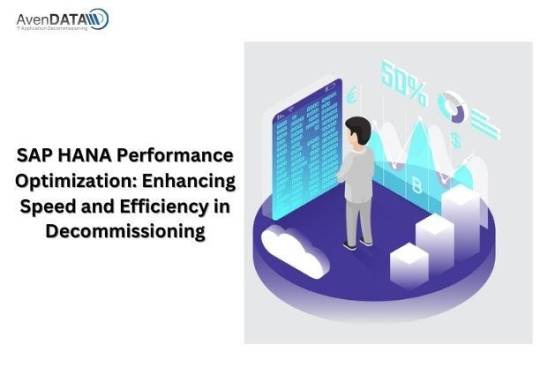
In today’s rapidly evolving business landscape, organizations are continually seeking ways to optimize their operations and maximize efficiency. When it comes to legacy system decommissioning, speed and efficiency are paramount to ensure a smooth transition and minimize disruption to business processes. SAP HANA, with its cutting-edge in-memory computing capabilities, offers a powerful platform for accelerating decommissioning processes and optimizing performance. In this blog, we’ll explore how organizations can leverage SAP HANA performance optimization techniques to enhance speed and efficiency in decommissioning initiatives.
Understanding SAP HANA Performance Optimization
SAP HANA is renowned for its exceptional performance, thanks to its innovative in-memory computing architecture, columnar storage, and advanced processing capabilities. By storing data in-memory and processing it in parallel, SAP HANA can deliver lightning-fast query response times and enable real-time analytics on large datasets. When applied to decommissioning projects, SAP HANA performance optimization techniques can significantly accelerate data migration, transformation, and analysis tasks, leading to faster project completion and cost savings.
Key Strategies for SAP HANA Performance Optimization in Decommissioning:
Data Partitioning and Distribution: SAP HANA allows organizations to partition and distribute data across multiple nodes to leverage parallel processing capabilities and maximize system performance. By strategically partitioning data based on usage patterns, organizations can optimize query performance and accelerate data retrieval and processing tasks during decommissioning.
Columnar Storage Optimization: SAP HANA’s columnar storage architecture minimizes data footprint and enhances query performance by storing data in columns rather than rows. By compressing and indexing columnar data, organizations can achieve significant storage savings and improve query execution times, resulting in faster data retrieval and analysis during decommissioning.
Memory Management and Caching: SAP HANA’s intelligent memory management and caching mechanisms optimize memory utilization and accelerate data access by caching frequently accessed data and preloading query results into memory. By configuring memory parameters and cache settings, organizations can ensure optimal performance and responsiveness during decommissioning tasks.
Parallel Processing and Multithreading: SAP HANA leverages parallel processing and multithreading techniques to execute queries and data processing tasks in parallel across multiple CPU cores. By harnessing the power of parallelism, organizations can distribute workloads efficiently and maximize CPU utilization, leading to faster query execution and data processing in decommissioning projects.
Query Optimization and Indexing: SAP HANA’s query optimization engine automatically optimizes query execution plans and selects the most efficient access paths based on data distribution and query predicates. Additionally, organizations can create custom indexes and materialized views to further optimize query performance and accelerate data retrieval during decommissioning.
Benefits of SAP HANA Performance Optimization in Decommissioning:
Faster Data Migration: By accelerating data transfer and processing tasks, SAP HANA performance optimization techniques enable faster data migration from legacy systems to target environments, reducing downtime and minimizing disruption to business operations.
Improved Query Performance: SAP HANA’s superior query performance ensures faster data retrieval and analysis, enabling organizations to make informed decisions quickly and efficiently during decommissioning projects.
Reduced Resource Consumption: By optimizing resource utilization and minimizing data footprint, SAP HANA performance optimization techniques help organizations reduce hardware requirements, lower infrastructure costs, and achieve greater operational efficiency in decommissioning initiatives.
Enhanced Scalability and Flexibility: SAP HANA’s scalable architecture and flexible deployment options allow organizations to scale their decommissioning efforts seamlessly to accommodate growing data volumes and evolving business needs, ensuring long-term scalability and flexibility.
Conclusion:
SAP HANA performance optimization techniques offer a powerful toolkit for organizations seeking to accelerate decommissioning projects and maximize efficiency. By leveraging data partitioning, columnar storage, memory management, parallel processing, and query optimization techniques, organizations can unlock the full potential of SAP HANA’s in-memory computing platform and achieve faster data migration, analysis, and decision-making in decommissioning initiatives. With SAP HANA as a strategic ally, organizations can streamline decommissioning processes, minimize downtime, and unlock new opportunities for innovation and growth.
1 note
·
View note
Text
Legacy Systems: The Key to Competitive Advantage
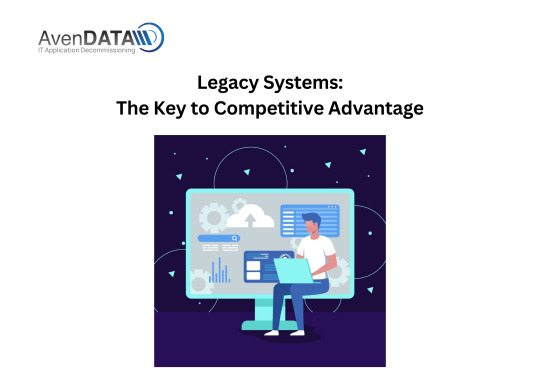
Introduction: In today’s fast-paced technological landscape, organizations often perceive legacy systems as outdated and inefficient. However, it is time to challenge this conventional wisdom. IT Legacy systems, built on a foundation of reliability, stability, and institutional knowledge, can actually be the key to gaining a competitive advantage. This blog explores how legacy systems can provide unique benefits and unlock opportunities for organizations to thrive in the modern business landscape.
Unmatched Domain Expertise: Legacy systems are often deeply ingrained in an organization’s operations, reflecting years or even decades of industry-specific knowledge and insights. These systems are finely tuned to address the unique challenges and requirements of the business, making them a valuable repository of domain expertise. Leveraging this expertise can provide organizations with a competitive edge, as it enables them to make informed decisions, optimize processes, and deliver tailored solutions to customers.
Stability and Reliability: One of the hallmarks of legacy systems is their stability and reliability. These systems have a proven track record of supporting critical business functions, often serving as the backbone of operations for years. By maintaining and optimizing legacy systems, organizations can ensure uninterrupted and consistent service delivery to their customers, establishing a reputation for reliability that sets them apart from competitors. Reliability and stability contribute to customer trust and loyalty, key factors for long-term success.
Cost-Effectiveness: While legacy systems may require ongoing maintenance, they often operate at a lower cost compared to implementing entirely new systems. The initial investment in legacy systems has already been made, and organizations can continue to extract value from these systems by optimizing performance, enhancing security measures, and gradually modernizing specific components. This cost-effectiveness frees up resources that can be allocated to other strategic initiatives, providing a competitive advantage in terms of financial stability and flexibility.
Seamless Integration: Legacy systems have historically been built to integrate with other systems and processes within an organization. These systems often have well-established interfaces and integrations with other applications and platforms, allowing for seamless data exchange and interoperability. This integration capability provides organizations with the advantage of leveraging existing infrastructure and data assets while incorporating new technologies and innovations into their IT ecosystem.
Incremental Modernization: Rather than discarding legacy systems entirely, organizations can adopt an incremental modernization approach. This strategy allows for the preservation of the core functionality and value of legacy systems while gradually introducing new technologies and architectures. Incremental modernization minimizes disruption, reduces implementation risks, and maximizes the value derived from legacy systems.
Security and Compliance: Legacy systems, although built on older technologies, can still meet security and compliance requirements with the appropriate measures in place. By implementing robust cybersecurity measures, regular updates, and monitoring protocols, organizations can ensure the protection of sensitive data and compliance with industry regulations. This commitment to security and compliance enhances customer trust and strengthens the organization’s competitive position.
Conclusion: Contrary to popular belief, legacy systems hold a wealth of untapped potential that can provide organizations with a competitive advantage. The unmatched domain expertise, stability, reliability, cost-effectiveness, seamless integration, and the opportunity for incremental modernization are just a few of the benefits that legacy systems offer. By understanding and leveraging the strengths of legacy systems, organizations can harness their unique advantages to drive innovation, optimize processes, deliver exceptional customer experiences, and maintain a competitive edge in the ever-evolving business landscape. Embrace and optimize your legacy systems, and unlock the potential for sustained success and growth.
#avendata #legacysystems #legacysystem #itsystems #itlegacysystems
0 notes
Text
The Legacy Equation: Balancing Old and New in IT Systems

Introduction: In the realm of IT systems, organizations often find themselves grappling with the challenge of balancing legacy systems, which have long been the backbone of their operations, with the need to embrace new technologies and innovations. This delicate equilibrium is crucial to ensure smooth operations, maximize efficiency, and foster continued growth. In this blog, we explore the legacy equation and shed light on strategies for effectively balancing old and new in IT systems.
Understanding Legacy Systems: IT Legacy systems, often built on outdated technologies, hold valuable institutional knowledge and are deeply ingrained in an organization’s operations. They have proven their reliability over time and are trusted to handle critical business functions. However, they also come with certain limitations:
a. Inflexibility: Legacy systems can be rigid and challenging to modify or integrate with modern technologies. This lack of flexibility can hinder innovation and the ability to adapt to evolving business requirements.
b. Cost of Maintenance: Maintaining legacy systems can be costly, as they often require specialized expertise, regular updates, and ongoing support. These expenses can strain resources and divert funds from strategic initiatives.
c. Security Risks: Outdated systems may lack robust security features and are more susceptible to cyber threats. This poses a significant risk to sensitive data and exposes organizations to potential breaches and regulatory non-compliance.
Embracing New Technologies: While legacy systems have their merits, embracing new technologies is essential to stay competitive and meet evolving business needs. Here are strategies for effectively incorporating new technologies into your IT ecosystem:
a. Identify Pain Points: Assess your organization’s pain points and areas where legacy systems are holding back progress. Identify specific business areas that could benefit from modernization, such as customer experience, data analytics, or workflow automation.
b. Prioritize Modernization: Prioritize which systems or processes to modernize based on their impact on business outcomes and potential return on investment. This approach allows for a phased transition and minimizes disruption.
c. Cloud Adoption: Explore the benefits of cloud computing, which offers scalability, cost efficiency, and enhanced collaboration. Migrating certain functions or applications to the cloud can help modernize your IT infrastructure while preserving legacy systems in the short term.
d. Hybrid Approach: Consider adopting a hybrid IT approach that combines legacy systems with newer technologies. This approach allows organizations to leverage the strengths of both systems while gradually transitioning to a more modern framework.
e. Application Programming Interfaces (APIs): APIs enable seamless integration between legacy and modern systems, facilitating data exchange and interoperability. By connecting legacy systems with newer applications through APIs, organizations can extend the lifespan of their legacy investments while gaining the benefits of modern functionality.
Mitigating Risks and Challenges: As you strive to strike a balance between old and new in your IT systems, it is important to address potential risks and challenges:
a. Security Measures: Implement robust security measures to protect both legacy and modern systems. Regular vulnerability assessments, encryption, and access controls are crucial to safeguarding your IT infrastructure against cyber threats.
b. Data Migration: When modernizing, ensure a smooth transition of data from legacy systems to new platforms. Develop a comprehensive data migration plan that includes data cleansing, validation, and testing to maintain data integrity.
c. Change Management: Proper change management is vital to ensure a smooth transition from legacy to modern systems. Involve stakeholders, communicate the benefits of the transition, and provide training and support to help employees adapt to the new technologies.
d. Preservation of Institutional Knowledge: Legacy systems often contain valuable institutional knowledge. Ensure that this knowledge is documented and transferred to new systems or shared with relevant stakeholders to preserve its value.
Leveraging the Best of Both Worlds: By striking the right balance between old and new in your IT systems, organizations can leverage the best of both worlds. Legacy systems provide stability, reliability, and institutional knowledge, while new technologies offer innovation, scalability, and agility. The key lies in identifying the right areas for modernization and strategically integrating new technologies to enhance the overall efficiency and effectiveness of your IT ecosystem.
Conclusion: The legacy equation is a delicate balance that organizations must strike between their trusted legacy systems and the need to embrace new technologies. By understanding the strengths and limitations of legacy systems, prioritizing modernization efforts, and mitigating associated risks, organizations can effectively incorporate new technologies while leveraging the institutional knowledge embedded in their legacy systems. With careful planning, organizations can navigate the path of IT modernization and achieve a harmonious equilibrium that drives innovation, efficiency, and growth.
#avendata #legacysystems #legacysystem #itsystems #itlegacysystems
0 notes
Text
Breaking the Chains: Liberating Your Business from IT Legacy Systems
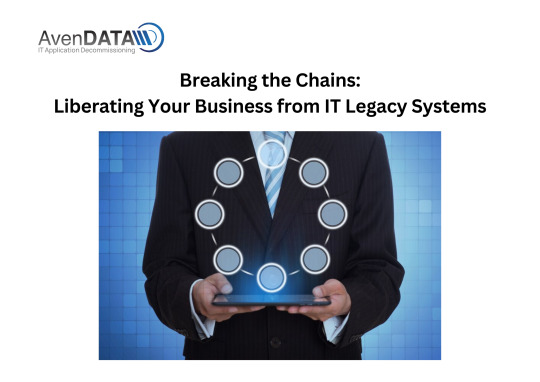
Introduction: In today’s fast-paced digital world, businesses rely heavily on their IT systems to drive efficiency, productivity, and innovation. However, many organizations find themselves chained to outdated and cumbersome legacy systems that hinder growth and agility. This blog explores the importance of liberating businesses from IT legacy systems, highlighting the benefits, challenges, and strategies involved in this transformative process.
Understanding Legacy System Challenges: Legacy systems, often built on outdated technologies, come with a host of challenges that impede business operations and growth:
a. Inflexibility: Legacy systems are typically rigid and difficult to modify or integrate with modern technologies. This lack of flexibility limits the ability to adapt to changing business needs and hinders innovation.
b. High Maintenance Costs: Legacy systems require substantial investments in maintenance, upgrades, and specialized expertise. These costs can strain resources and divert funds from strategic initiatives.
c. Security Risks: Outdated systems are vulnerable to security breaches and lack the robust protections offered by modern cybersecurity measures. This puts businesses at risk of data breaches, compromising sensitive information and damaging their reputation.
d. Limited Scalability: Legacy systems often struggle to handle increased workloads and lack the scalability required for business growth. This can result in performance issues, system failures, and delays in serving customer needs.
Liberating Your Business: To break free from the constraints of legacy systems and embrace digital transformation, consider the following strategies:
a. Assess and Prioritize: Begin by assessing your current IT landscape and identifying the key pain points and inefficiencies caused by legacy systems. Prioritize areas that require immediate attention and align with strategic business objectives.
b. Develop a Migration Plan: Create a comprehensive plan detailing the steps and timeline for migrating away from legacy systems. This plan should include a clear vision, goals, resource allocation, and risk mitigation strategies.
c. Embrace Cloud Computing: Cloud-based solutions offer significant advantages, including scalability, flexibility, and reduced maintenance costs. Consider migrating key IT functions, such as data storage, application hosting, and infrastructure, to the cloud.
d. Adopt Modern Technologies: Explore modern technologies, such as SaaS (Software-as-a-Service) applications, AI (Artificial Intelligence), and automation tools. These technologies can streamline operations, improve efficiency, and enable faster innovation.
e. Implement Data Migration Strategies: Develop a robust data migration strategy to ensure the safe and accurate transfer of data from legacy systems to modern platforms. This includes data cleansing, data mapping, and validation to maintain data integrity throughout the migration process.
f. Invest in Training and Change Management: Ensure that employees are equipped with the necessary skills to adapt to new systems and processes. Invest in training programs and change management initiatives to foster a smooth transition and minimize disruption.
g. Prioritize Security: As you transition away from legacy systems, prioritize cybersecurity measures to protect sensitive data and mitigate risks. Implement robust security protocols, regular vulnerability assessments, and employee training to safeguard your digital assets.
Benefits of Liberation: Liberating your business from IT legacy systems can bring numerous benefits:
a. Improved Efficiency: Modern systems enable streamlined processes, automation, and real-time data access, enhancing overall operational efficiency and productivity.
b. Enhanced Agility: Breaking free from legacy systems allows businesses to respond quickly to market changes, adapt to evolving customer needs, and drive innovation.
c. Cost Optimization: By eliminating high maintenance costs associated with legacy systems, organizations can allocate resources towards strategic initiatives and invest in technologies that drive growth.
d. Scalability and Flexibility: Modern systems offer scalability to handle increased workloads, accommodate growth, and support business expansion effectively.
e. Competitive Advantage: Embracing modern technologies gives businesses a competitive edge by enabling faster time-to-market, improved customer experiences, and increased business agility.
Conclusion: Breaking free from the chains of IT legacy systems is crucial for businesses looking to thrive in a rapidly evolving digital landscape. By understanding the challenges posed by legacy systems, developing a migration plan, embracing modern technologies, and prioritizing security, organizations can liberate themselves from outdated systems and unlock the benefits of enhanced efficiency, cost optimization, scalability, and agility. Embrace the digital transformation journey, and empower your business to adapt, innovate, and flourish in the digital era.
#avendata #legacysystems #legacysystem #itsystems #itlegacysystems
0 notes